Kazuhiko Murasaki
Objective, Absolute and Hue-aware Metrics for Intrinsic Image Decomposition on Real-World Scenes: A Proof of Concept
May 26, 2025Abstract:Intrinsic image decomposition (IID) is the task of separating an image into albedo and shade. In real-world scenes, it is difficult to quantitatively assess IID quality due to the unavailability of ground truth. The existing method provides the relative reflection intensities based on human-judged annotations. However, these annotations have challenges in subjectivity, relative evaluation, and hue non-assessment. To address these, we propose a concept of quantitative evaluation with a calculated albedo from a hyperspectral imaging and light detection and ranging (LiDAR) intensity. Additionally, we introduce an optional albedo densification approach based on spectral similarity. This paper conducted a concept verification in a laboratory environment, and suggested the feasibility of an objective, absolute, and hue-aware assessment. (This paper is accepted by IEEE ICIP 2025. )
Memory-Efficient Point Cloud Registration via Overlapping Region Sampling
Oct 29, 2024Abstract:Recent advances in deep learning have improved 3D point cloud registration but increased graphics processing unit (GPU) memory usage, often requiring preliminary sampling that reduces accuracy. We propose an overlapping region sampling method to reduce memory usage while maintaining accuracy. Our approach estimates the overlapping region and intensively samples from it, using a k-nearest-neighbor (kNN) based point compression mechanism with multi layer perceptron (MLP) and transformer architectures. Evaluations on 3DMatch and 3DLoMatch datasets show our method outperforms other sampling methods in registration recall, especially at lower GPU memory levels. For 3DMatch, we achieve 94% recall with 33% reduced memory usage, with greater advantages in 3DLoMatch. Our method enables efficient large-scale point cloud registration in resource-constrained environments, maintaining high accuracy while significantly reducing memory requirements.
Unsupervised Intrinsic Image Decomposition with LiDAR Intensity Enhanced Training
Mar 21, 2024Abstract:Unsupervised intrinsic image decomposition (IID) is the process of separating a natural image into albedo and shade without these ground truths. A recent model employing light detection and ranging (LiDAR) intensity demonstrated impressive performance, though the necessity of LiDAR intensity during inference restricts its practicality. Thus, IID models employing only a single image during inference while keeping as high IID quality as the one with an image plus LiDAR intensity are highly desired. To address this challenge, we propose a novel approach that utilizes only an image during inference while utilizing an image and LiDAR intensity during training. Specifically, we introduce a partially-shared model that accepts an image and LiDAR intensity individually using a different specific encoder but processes them together in specific components to learn shared representations. In addition, to enhance IID quality, we propose albedo-alignment loss and image-LiDAR conversion (ILC) paths. Albedo-alignment loss aligns the gray-scale albedo from an image to that inferred from LiDAR intensity, thereby reducing cast shadows in albedo from an image due to the absence of cast shadows in LiDAR intensity. Furthermore, to translate the input image into albedo and shade style while keeping the image contents, the input image is separated into style code and content code by encoders. The ILC path mutually translates the image and LiDAR intensity, which share content but differ in style, contributing to the distinct differentiation of style from content. Consequently, LIET achieves comparable IID quality to the existing model with LiDAR intensity, while utilizing only an image without LiDAR intensity during inference.
End-to-end learning potentials for structured attribute prediction
Aug 06, 2017
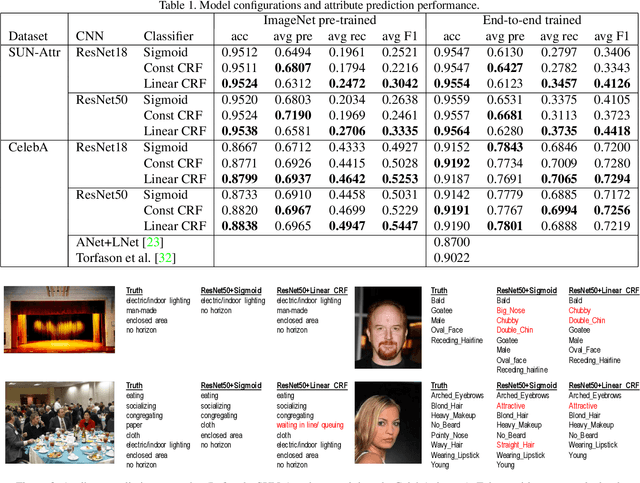
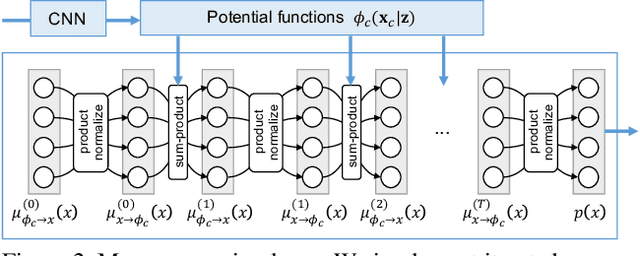

Abstract:We present a structured inference approach in deep neural networks for multiple attribute prediction. In attribute prediction, a common approach is to learn independent classifiers on top of a good feature representation. However, such classifiers assume conditional independence on features and do not explicitly consider the dependency between attributes in the inference process. We propose to formulate attribute prediction in terms of marginal inference in the conditional random field. We model potential functions by deep neural networks and apply the sum-product algorithm to solve for the approximate marginal distribution in feed-forward networks. Our message passing layer implements sparse pairwise potentials by a softplus-linear function that is equivalent to a higher-order classifier, and learns all the model parameters by end-to-end back propagation. The experimental results using SUN attributes and CelebA datasets suggest that the structured inference improves the attribute prediction performance, and possibly uncovers the hidden relationship between attributes.
Automatic Attribute Discovery with Neural Activations
Jul 25, 2016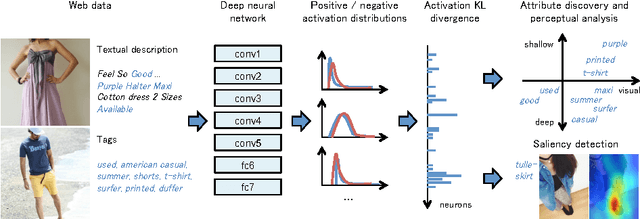
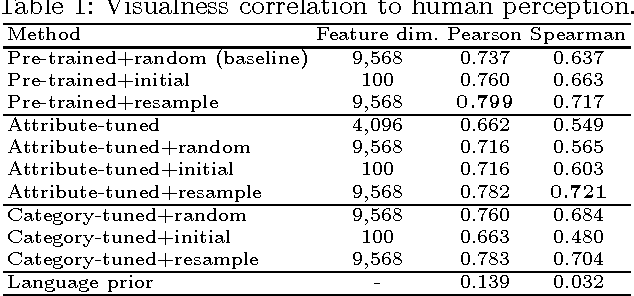

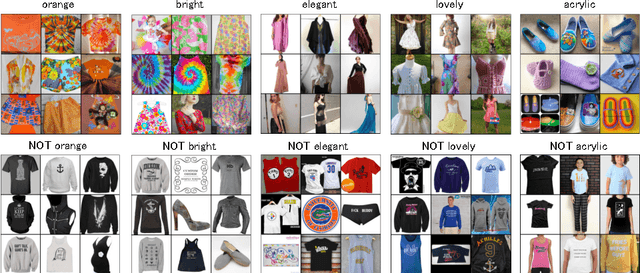
Abstract:How can a machine learn to recognize visual attributes emerging out of online community without a definitive supervised dataset? This paper proposes an automatic approach to discover and analyze visual attributes from a noisy collection of image-text data on the Web. Our approach is based on the relationship between attributes and neural activations in the deep network. We characterize the visual property of the attribute word as a divergence within weakly-annotated set of images. We show that the neural activations are useful for discovering and learning a classifier that well agrees with human perception from the noisy real-world Web data. The empirical study suggests the layered structure of the deep neural networks also gives us insights into the perceptual depth of the given word. Finally, we demonstrate that we can utilize highly-activating neurons for finding semantically relevant regions.
 Add to Chrome
Add to Chrome Add to Firefox
Add to Firefox Add to Edge
Add to Edge